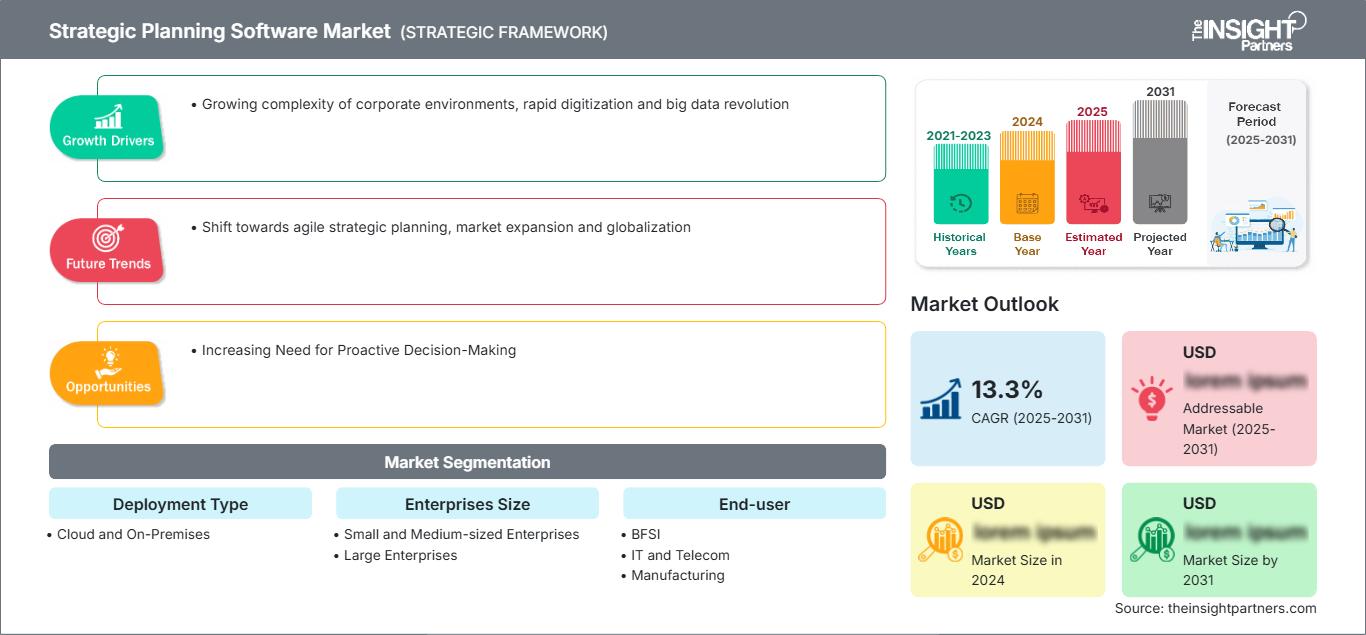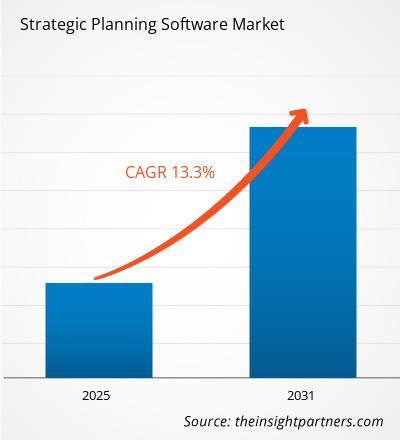Der Markt für strategische Planungssoftware wird zwischen 2023 und 2031 voraussichtlich eine durchschnittliche jährliche Wachstumsrate (CAGR) von 13,3 % verzeichnen. Der Wandel hin zu agiler strategischer Planung sowie die Marktexpansion und Globalisierung bleiben voraussichtlich die wichtigsten Trends auf dem Markt.
Marktanalyse für strategische Planungssoftware
- Die Aussichten für die Einführung strategischer Planungssoftware sind heute rosig. Viele Branchen nutzen diese Software, um die Komplexität des Geschäftsumfelds zu meistern, Informationen für die Entscheidungsfindung bereitzustellen und Wettbewerbsvorteile zu erzielen.
- Da Entscheidungen immer dringlicher werden, um auf die Herausforderungen des Geschäftsumfelds zu reagieren, steigt die Nachfrage nach strategischer Planungssoftware. Darüber hinaus erfordert die Komplexität heutiger Unternehmensumgebungen den Einsatz strategischer Planungssoftware, um die Entscheidungsfindung zu erleichtern und den Wettbewerbsvorteil zu steigern.
- Technologische Fortschritte, insbesondere bei der Integration künstlicher Intelligenz (KI), der Nutzung prädiktiver Analysen und einer neuen Welle der Leistungsmessung von Unternehmen, tragen zum Wachstum und zur Expansion des Marktes für strategische Planungssoftware bei.
Marktübersicht für strategische Planungssoftware
- Der Markt für strategische Planungssoftware verzeichnet aufgrund seiner breiten Verbreitung in verschiedenen Branchen ein starkes Wachstum. Die zunehmende Geschäftskomplexität entsteht durch ständige Störungen im Umfeld und Veränderungen der Marktkräfte/demografischen Entwicklung.
- Unternehmen haben diesen Faktor erkannt und ziehen den Einsatz von Tools in Betracht, die ihnen helfen, kritische Geschäftsentscheidungen zu antizipieren, Risiken proaktiv zu minimieren oder zu planen und Chancen in jeder Situation zu maximieren. Strategische Planungssoftware ermöglicht es Unternehmen, Daten zu analysieren, mit virtuellen Teams zusammenzuarbeiten und die Leistung im Verhältnis zu festgelegten Strategien/Zielen als Reaktion auf sich ändernde Marktdynamiken zu verfolgen.
Passen Sie diesen Bericht Ihren Anforderungen an
Sie erhalten kostenlos Anpassungen an jedem Bericht, einschließlich Teilen dieses Berichts oder einer Analyse auf Länderebene, eines Excel-Datenpakets sowie tolle Angebote und Rabatte für Start-ups und Universitäten.
Markt für strategische Planungssoftware: Strategische Einblicke

- Holen Sie sich die wichtigsten Markttrends aus diesem Bericht.Dieses KOSTENLOSE Beispiel umfasst Datenanalysen, die von Markttrends bis hin zu Schätzungen und Prognosen reichen.
Treiber und Chancen für den Markt für strategische Planungssoftware: Wachsende Komplexität von Unternehmensumgebungen begünstigt den Markt
Sie erhalten kostenlos Anpassungen an jedem Bericht, einschließlich Teilen dieses Berichts oder einer Analyse auf Länderebene, eines Excel-Datenpakets sowie tolle Angebote und Rabatte für Start-ups und Universitäten.
Markt für strategische Planungssoftware: Strategische Einblicke

- Holen Sie sich die wichtigsten Markttrends aus diesem Bericht.Dieses KOSTENLOSE Beispiel umfasst Datenanalysen, die von Markttrends bis hin zu Schätzungen und Prognosen reichen.
- Die zunehmende Komplexität der Unternehmensumgebung treibt jedoch das Wachstum des Marktes für strategische Planungssoftware voran. Einerseits bringt eine wachsende Geschäftskomplexität mit sich, dass Unternehmen mit dynamischeren, komplexeren und unvorhersehbareren Marktbedingungen konfrontiert werden.
- Andererseits erfordert sie entsprechend umfassendere Datenanalysen, um den Markt besser zu verstehen, Risiken vorherzusehen, Chancen zu erkennen und Unsicherheiten zu begegnen.
- Strategische Planungssoftware ermöglicht es Unternehmen, datengestützte Entscheidungen auf Grundlage sorgfältig durchgeführter Analysen zu treffen. Sie gibt Unternehmen zudem die Möglichkeit, die Komplexität der Betriebsumgebung mit den finanziellen und personellen Ressourcen in Einklang zu bringen, die das Unternehmen sinnvoll einsetzen und kontrollieren kann.
- Mit anderen Worten: Heutzutage ist es für Unternehmen wichtig, sich an die zunehmende Komplexität ihrer Betriebsumgebungen anzupassen, um ihre eigene Agilität und Fähigkeit zur Antizipation von Veränderungen sicherzustellen. Dieser Umfeldfaktor treibt den Bedarf an strategischer Planungssoftware voran.
Steigender Bedarf an proaktiver Entscheidungsfindung
- Angesichts der wachsenden Nachfrage nach vorausschauender Entscheidungsfindung benötigen Unternehmen eine Plattform, um schnelle, datenbasierte Entscheidungen auf Grundlage der sich verändernden Geschäftslandschaft zu treffen und so Chancen besser zu nutzen und Risiken zu minimieren.
- Strategische Planungssoftware ermöglicht ihren Nutzern die Erstellung ausgefeilter und maßgeschneiderter Modelle, die zu besseren und früheren Entscheidungen führen. Die Software bietet Tools und Funktionen zur Datenanalyse, zum Erkennen von Mustern und zur Anpassung sich entwickelnder Strategien an die sich verändernde Geschäftslandschaft.
- Mit strategischer Planungssoftware können Unternehmen schnelle, proaktive Entscheidungen treffen, um in einem dynamischen Geschäftsumfeld schneller voranzukommen und Marktchancen zu nutzen. Die Nachfrage nach strategischer Planungssoftware beruht auf dem Ziel, die Unternehmensleistung zu verbessern und strategischen Erfolg in einem sich ständig weiterentwickelnden Geschäftsumfeld zu erzielen.
Segmentierungsanalyse des Marktberichts für strategische Planungssoftware
Schlüsselsegmente, die zur Ableitung der Marktanalyse für strategische Planungssoftware beigetragen haben, sind Bereitstellungstyp, Unternehmensgröße und Endbenutzer.
- Basierend auf dem Bereitstellungstyp wird der Markt für strategische Planungssoftware in Cloud und On-Premises unterteilt.
- Basierend auf der Unternehmensgröße wird der Markt für strategische Planungssoftware in kleine und mittlere Unternehmen sowie große Unternehmen unterteilt.
- Basierend auf dem Endbenutzer wird der Markt für strategische Planungssoftware in BFSI, IT und Telekommunikation, Fertigung, Gesundheitswesen, Einzelhandel und andere unterteilt.
Marktanteilsanalyse für strategische Planungssoftware nach Geografie
- Der Marktbericht für strategische Planungssoftware umfasst eine detaillierte Analyse von fünf großen geografischen Regionen, die aktuelle und historische Marktgrößen sowie Prognosen für 2021 bis 2031, umfasst Nordamerika, Europa, Asien-Pazifik (APAC), Naher Osten und Afrika (MEA) sowie Süd- und Mittelamerika.
- Jede Region ist weiter in entsprechende Länder unterteilt. Dieser Bericht bietet Analysen und Prognosen für mehr als 18 Länder und deckt die Marktdynamik von strategischer Planungssoftware ab, wie z. B. Treiber, Trends und Chancen, die die Märkte auf regionaler Ebene beeinflussen.
- Darüber hinaus umfasst der Bericht eine PEST-Analyse, die die Untersuchung der wichtigsten Faktoren umfasst, die den Markt für strategische Planungssoftware in diesen Regionen beeinflussen.
Markt für strategische Planungssoftware
Die Analysten von The Insight Partners haben die regionalen Trends und Faktoren, die den Markt für strategische Planungssoftware im Prognosezeitraum beeinflussen, ausführlich erläutert. In diesem Abschnitt werden auch die Marktsegmente und die geografische Lage in Nordamerika, Europa, dem asiatisch-pazifischen Raum, dem Nahen Osten und Afrika sowie Süd- und Mittelamerika erörtert.Umfang des Marktberichts über strategische Planungssoftware
| Berichtsattribut | Einzelheiten |
|---|---|
| Marktgröße in 2024 | US$ XX million |
| Marktgröße nach 2031 | US$ XX Million |
| Globale CAGR (2025 - 2031) | 13.3% |
| Historische Daten | 2021-2023 |
| Prognosezeitraum | 2025-2031 |
| Abgedeckte Segmente |
By Bereitstellungstyp
|
| Abgedeckte Regionen und Länder | Nordamerika
|
| Marktführer und wichtige Unternehmensprofile |
|
Dichte der Marktteilnehmer für strategische Planungssoftware: Verständnis ihrer Auswirkungen auf die Geschäftsdynamik
Der Markt für strategische Planungssoftware wächst rasant. Dies ist auf die steigende Nachfrage der Endnutzer zurückzuführen, die auf Faktoren wie veränderte Verbraucherpräferenzen, technologische Fortschritte und ein stärkeres Bewusstsein für die Produktvorteile zurückzuführen ist. Mit der steigenden Nachfrage erweitern Unternehmen ihr Angebot, entwickeln Innovationen, um den Bedürfnissen der Verbraucher gerecht zu werden, und nutzen neue Trends, was das Marktwachstum weiter ankurbelt.
- Holen Sie sich die Markt für strategische Planungssoftware Übersicht der wichtigsten Akteure
Der Markt für strategische Planungssoftware wird durch die Erhebung qualitativer und quantitativer Daten nach Primär- und Sekundärforschung bewertet, die wichtige Unternehmenspublikationen, Verbandsdaten und Datenbanken umfasst. Einige der Entwicklungen auf dem Markt für strategische Planungssoftware sind nachfolgend aufgeführt:
- ClearPoint Strategy, führender Anbieter von Performance-Management- und strategischer Planungssoftware, hat zwei innovative Neuerungen vorgestellt, die die Art und Weise, wie Unternehmen kommunizieren und ihre strategischen Pläne verwalten, grundlegend verändern werden. (Quelle: ClearPoint Strategy, Pressemitteilung, Januar 2024)
Bericht zum Markt für strategische Planungssoftware: Umfang und Ergebnisse
Der „Markt für strategische Planungssoftware – Größe und Prognose (2021–2031)“ Der Bericht bietet eine detaillierte Analyse des Marktes und deckt die folgenden Bereiche ab:
- Marktgröße und Prognose für strategische Planungssoftware auf globaler, regionaler und Länderebene für alle abgedeckten wichtigen Marktsegmente
- Markttrends und Marktdynamiken für strategische Planungssoftware wie Treiber, Einschränkungen und wichtige Chancen
- Detaillierte PEST/Porters Five Forces- und SWOT-Analyse
- Marktanalyse für strategische Planungssoftware mit wichtigen Markttrends, globalen und regionalen Rahmenbedingungen, wichtigen Akteuren, Vorschriften und aktuellen Marktentwicklungen
- Branchenlandschafts- und Wettbewerbsanalyse mit Marktkonzentration, Heatmap-Analyse, prominenten Akteuren und aktuellen Entwicklungen für den Markt für strategische Planungssoftware
- Detaillierte Unternehmensprofile
- Historische Analyse (2 Jahre), Basisjahr, Prognose (7 Jahre) mit CAGR
- PEST- und SWOT-Analyse
- Marktgröße Wert/Volumen – Global, Regional, Land
- Branchen- und Wettbewerbslandschaft
- Excel-Datensatz
Aktuelle Berichte
Verwandte Berichte
Erfahrungsberichte
Grund zum Kauf
- Fundierte Entscheidungsfindung
- Marktdynamik verstehen
- Wettbewerbsanalyse
- Kundeneinblicke
- Marktprognosen
- Risikominimierung
- Strategische Planung
- Investitionsbegründung
- Identifizierung neuer Märkte
- Verbesserung von Marketingstrategien
- Steigerung der Betriebseffizienz
- Anpassung an regulatorische Trends






















 Kostenlose Probe anfordern für - Markt für strategische Planungssoftware
Kostenlose Probe anfordern für - Markt für strategische Planungssoftware